Abstract
To study trends in the incidence of and mortality from stroke in Stockholm during 1974-81 all cases (n = 56566) of stroke in patients aged over 40 were identified from the Swedish Cause of Death Register and the Inpatient Care Register. Information on the population at risk was obtained from the civil registration system. A multiplicative model was used to control for changes in the distribution of age during the study. Mortality from stroke decreased annually throughout the study by a mean of 2.3% for men and 3.5% for women. This favourable development was not accompanied by a similar decrease in the incidence of stroke. In men the total incidence (including recurrent strokes) and incidence of first stroke increased continuously. In women the total incidence showed virtually no change, whereas the incidence of first stroke decreased somewhat. These findings, in addition to an expected shift of age profile in the population towards more elderly people, should be considered in the planning of future health care resources.
Full text
PDF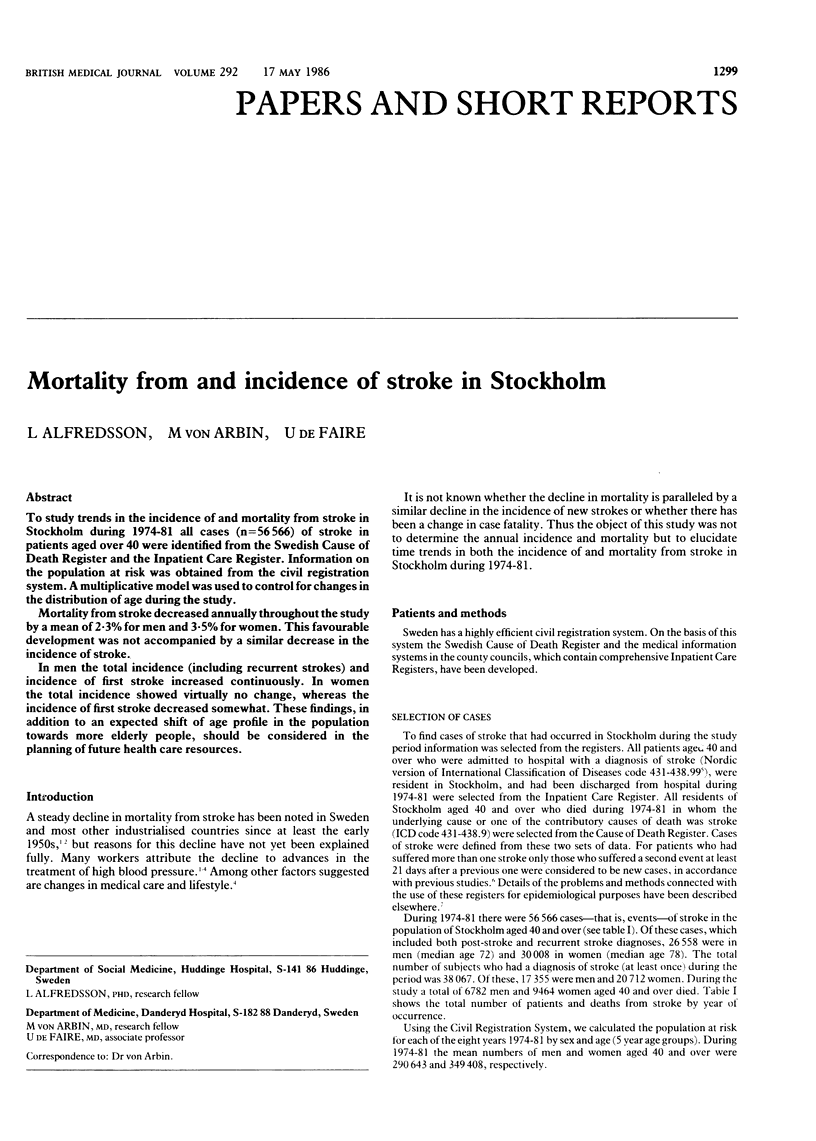
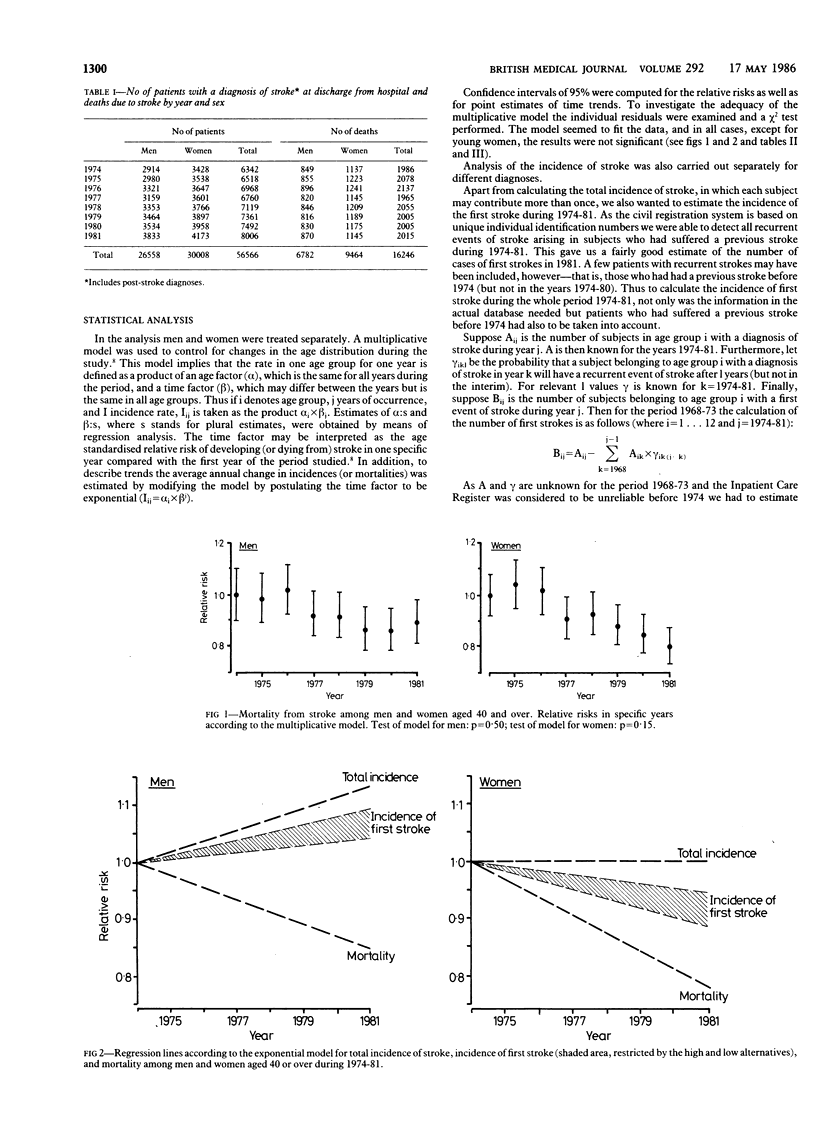
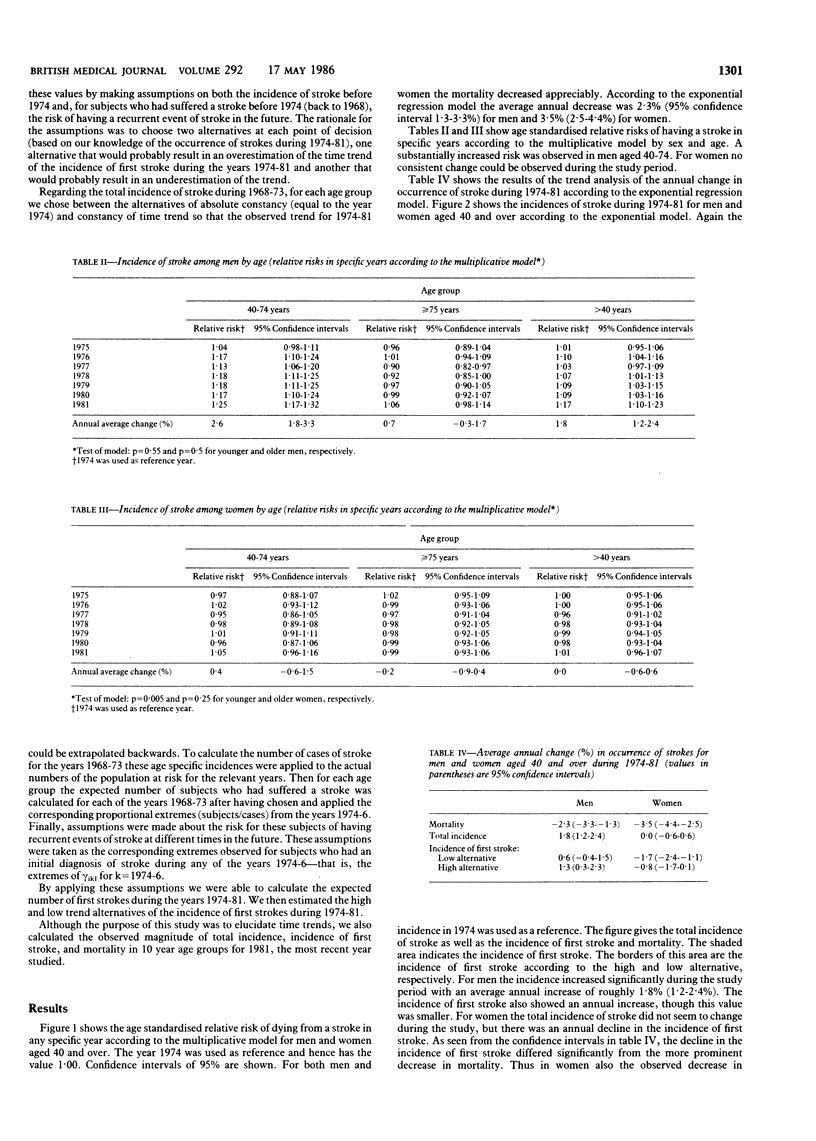
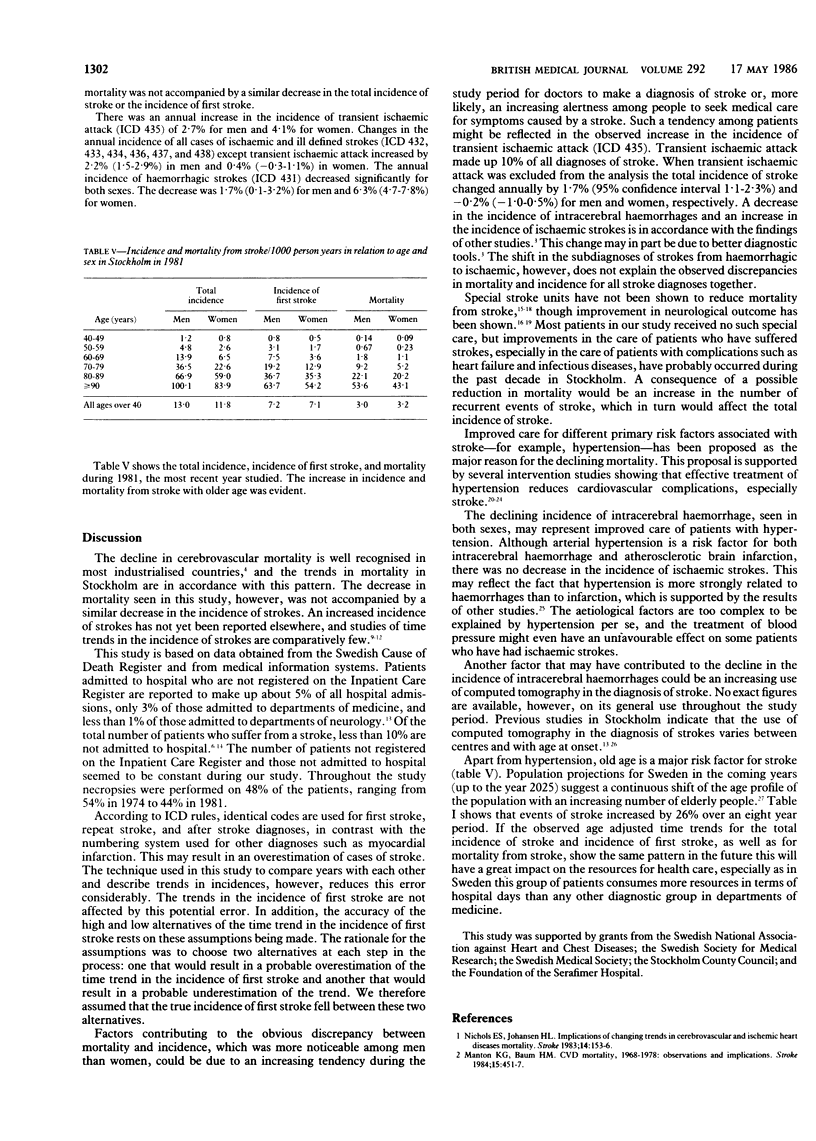
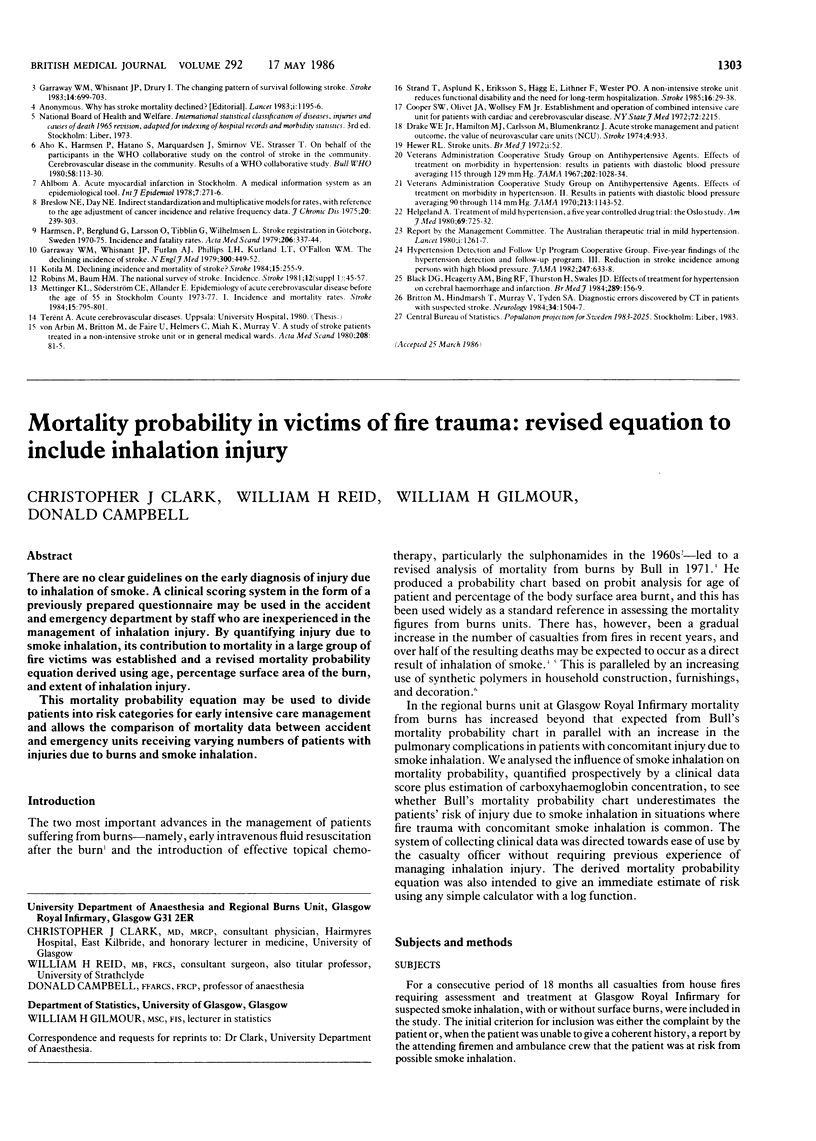
Selected References
These references are in PubMed. This may not be the complete list of references from this article.
- Ahlbom A. Acute myocardial infarction in Stockholm--a medical information system as an epidemiological tool. Int J Epidemiol. 1978 Sep;7(3):271–276. doi: 10.1093/ije/7.3.271. [DOI] [PubMed] [Google Scholar]
- Aho K., Harmsen P., Hatano S., Marquardsen J., Smirnov V. E., Strasser T. Cerebrovascular disease in the community: results of a WHO collaborative study. Bull World Health Organ. 1980;58(1):113–130. [PMC free article] [PubMed] [Google Scholar]
- Black D. G., Heagerty A. M., Bing R. F., Thurston H., Swales J. D. Effects of treatment for hypertension on cerebral haemorrhage and infarction. Br Med J (Clin Res Ed) 1984 Jul 21;289(6438):156–159. doi: 10.1136/bmj.289.6438.156. [DOI] [PMC free article] [PubMed] [Google Scholar]
- Breslow N. E., Day N. E. Indirect standardization and multiplicative models for rates, with reference to the age adjustment of cancer incidence and relative frequency data. J Chronic Dis. 1975 Jun;28(5-6):289–303. doi: 10.1016/0021-9681(75)90010-7. [DOI] [PubMed] [Google Scholar]
- Britton M., Hindmarsh T., Murray V., Tydén S. A. Diagnostic errors discovered by CT in patients with suspected stroke. Neurology. 1984 Nov;34(11):1504–1507. doi: 10.1212/wnl.34.11.1504. [DOI] [PubMed] [Google Scholar]
- Cooper S. W., Olivet J. A., Woolsey F. M., Jr Establishment and operation of combined intensive care unit. For patients with cardiac and cerebrovascular disease. N Y State J Med. 1972 Sep 1;72(17):2215–2220. [PubMed] [Google Scholar]
- Drake W. E., Jr, Hamilton M. J., Carlsson M., Blumenkrantz J. Acute stroke management and patient outcome: the value of Neurovascular Care Units (NCU). Stroke. 1973 Nov-Dec;4(6):933–945. doi: 10.1161/01.str.4.6.933. [DOI] [PubMed] [Google Scholar]
- Garraway W. M., Whisnant J. P., Drury I. The changing pattern of survival following stroke. Stroke. 1983 Sep-Oct;14(5):699–703. doi: 10.1161/01.str.14.5.699. [DOI] [PubMed] [Google Scholar]
- Garraway W. M., Whisnant J. P., Furlan A. J., Phillips L. H., 2nd, Kurland L. T., O'Fallon W. M. The declining incidence of stroke. N Engl J Med. 1979 Mar 1;300(9):449–452. doi: 10.1056/NEJM197903013000901. [DOI] [PubMed] [Google Scholar]
- Harmsen P., Berglund G., Larsson O., Tibblin G., Wilhelmsen L. Stroke registration in Göteborg, Sweden, 1970-75. Incidence and fatality rates. Acta Med Scand. 1979;206(5):337–344. doi: 10.1111/j.0954-6820.1979.tb13524.x. [DOI] [PubMed] [Google Scholar]
- Helgeland A. Treatment of mild hypertension: a five year controlled drug trial. The Oslo study. Am J Med. 1980 Nov;69(5):725–732. doi: 10.1016/0002-9343(80)90438-6. [DOI] [PubMed] [Google Scholar]
- Hewer R. L. Stroke units. Br Med J. 1972 Jan 1;1(5791):52–52. doi: 10.1136/bmj.1.5791.52. [DOI] [PMC free article] [PubMed] [Google Scholar]
- Kotila M. Declining incidence and mortality of stroke? Stroke. 1984 Mar-Apr;15(2):255–259. doi: 10.1161/01.str.15.2.255. [DOI] [PubMed] [Google Scholar]
- Mettinger K. L., Söderström C. E., Allander E. Epidemiology of acute cerebrovascular disease before the age of 55 in the Stockholm County 1973-77: I. Incidence and mortality rates. Stroke. 1984 Sep-Oct;15(5):795–801. doi: 10.1161/01.str.15.5.795. [DOI] [PubMed] [Google Scholar]
- Nicholls E. S., Johansen H. L. Implications of changing trends in cerebrovascular and ischemic heart disease mortality. Stroke. 1983 Mar-Apr;14(2):153–156. doi: 10.1161/01.str.14.2.153. [DOI] [PubMed] [Google Scholar]
- Strand T., Asplund K., Eriksson S., Hägg E., Lithner F., Wester P. O. A non-intensive stroke unit reduces functional disability and the need for long-term hospitalization. Stroke. 1985 Jan-Feb;16(1):29–34. doi: 10.1161/01.str.16.1.29. [DOI] [PubMed] [Google Scholar]
- von Arbin M., Britton M., deFaire U., Helmers C., Miah K., Murray V. A study of stroke patients treated in a non-intensive stroke unit or in general medical wards. Acta Med Scand. 1980;208(1-2):81–85. doi: 10.1111/j.0954-6820.1980.tb01156.x. [DOI] [PubMed] [Google Scholar]


